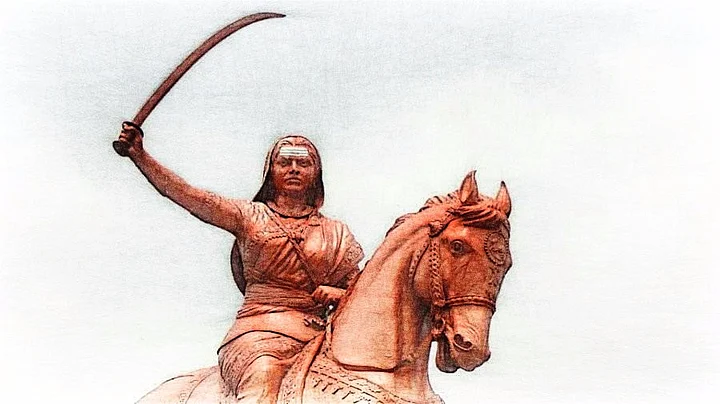The sword of a 19th century Karnataka warrior queen has been a unifying factor for the Lingayat community, which is protesting to get religious status. Several Lingayat leaders have been demanding the state and Central government to bring back the sword of Kittur Rani Chennamma, allegedly kept in a museum in London.
Though the campaign to reclaim this sword is gaining momentum in Karnataka, according to historians, no such sword exists as there is no record of it in any of London’s museums catalogue or that of Government of India.
Who is Kittur Rani Chennamma?
The controversy aside, Rani Chennemma remains one of the most prominent figures in Karnataka’s struggle against the British empire. A victim of British Raj’s doctrine of lapse, she took arms against the Raj, five decades before the Rani Laxmi Bai of Jhansi did so.
Chennemma and her husband, Raja Mallasarja, had a son who was the rightful heir to the throne. When her son died in 1824, she adopted Shivalingappa and made him the heir. However, the Britishers opposed this citing doctrine of lapse, which stated that without a rightful heir, the kingdom would be annexed by the empire.
Despite her repeated requests, the British marched to her kingdom to confiscate the treasures and jewels of Kittur – worth over Rs 1.5 million. And thus began the Battle of Kittur.
In the first wave of attack in October 1824, Chennemma defeated the 20,000-men and 400-guns-strong British forces and took two British officers, Sir Walter Elliot and Stevenson, as hostages.
Though the two officers were released on the condition that the siege of Kittur would stop, the British continued to attack. In the second round of attacks, despite her valiant efforts, Chennemma was captured. She died in captivity on 2 February 1829.
Legacy
On 11 September 2007, a statue of Rani Chennamma was unveiled at the Parliament complex in New Delhi by then president Pratibha Patil.
In Karnataka, the Lingayat community looks up to Chennamma as an idol, and she has become a symbol of the Lingayat community’s struggle for religious status. “Her significance to the Lingayat community is big, as she stands for the Lingayat identity,” said Shivanand Jamdar, former bureaucrat and coordinator of the the Lingayat Mahasabha.
Campaign For the Sword
One of the forerunners of the campaign to bring back the sword was Jaya Mrutyunajaya Swami, head of Panchamasli Mahapeetha of Koodalasangama, a prominent Lingayat leader. He recently announced that an all-party committee would be set up to liaise between the governments of India and the UK to get the sword back. The committee, he said, would be headed by former minister and BJP leader Murugesh Nirani.
Speaking to The Quint, Mrutyunajaya Swami said that a sustained campaign to put pressure on the state and Central government would begin from October 23 – Kittoor Rani Chennamma Jayanti, the birthday of the legendary fighter.
“There have been several requests made to the government to take proactive steps to get the sword back. We will continue to put pressure,” he said.
A delegation of leaders will be meeting External Affairs Minister Sushama Swaraj next week to take the matter up, he added.
No Record of the Sword
On 10 December 2014, Member of Parliament Rajiv Chandrashekar raised the issue in the Rajya Sabha. In his question titled ‘Reclaiming the antique sword of Rani Chenamma’, Chandrashekar asked the Ministry of Culture whether the antique swords of Chennamma were housed in a museum in London and what steps were being taken by the government to reclaim them.
The ministry answered: “No, sir. As per report received from High Commission of India at London, UK, no such object is displayed in British Museum at London.”
Historians Agree Too
Appanna Vaggar, professor of history, Karnataka University, said that so far there was no evidence to support that such was stored in London. Vaggar has completed his MPhil and PhD on Kittur and was part of the project to collect, translate, and publish documents related to Kittur. That team was led by professor MM Kalburgi.
According to him, the claim was based on citations from a book, Prizes of Kittur. “However, Prizes of Kittur is not a book. Catalogues of museums in London and London library are available online. There is no mention of such a sword. We have even gone through the 1854 Royal Aesthetic journal as well, but there was no mention of it either,” said Vaggar.
Talking about the sword, Jamdar said that he had not come across the any such sword during his visit to prominent Museums in London. However, when asked about the campaign by Lingayat leaders to get the sword back, he said he was unaware of the issue and couldn’t comment on it.
Despite the lack of records, the Lingayat leaders are going ahead with the demand to bring the sword back as it still remains a symbol for reuniting the Lingayat community, which is divided on the Lingayat religion.
(Breathe In, Breathe Out: Are you finding it tough to breathe polluted air? Join hands with FIT to find #PollutionKaSolution. Send in your suggestions to fit@thequint.com or WhatsApp @ +919999008335)
(At The Quint, we question everything. Play an active role in shaping our journalism by becoming a member today.)
